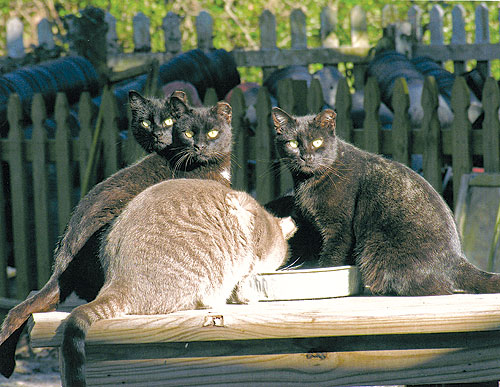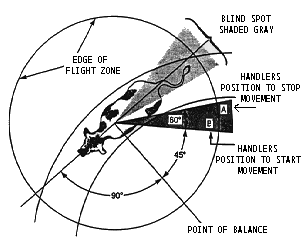What you can do
This is a list of simple things you can do by yourself to help out feral cats.
SPAY/NEUTER: First and foremost, if you have cats, they live outdoors and are not sterilized, get them fixed. If you live near any city with a population greater than 100,000 im 80% positive they have some kind of low cost spay/neuter programs for feral cats around. Start by looking in the phone book at animal rescues and shelters. There are also many webistes out there I am sure you found while you googled "Feral Cats". Otherwise all the unwanted cats will suffer and cause headaches and heartbreak for the people who deal with them. That is the biggest thing you can do to help. There are even programs in States like Illinois for low income spay neuter, and even a state sponsered feral cat program, where any citizen who can get thier governer or local animal control officer to write a letter to the health department, can be declared a feral cat colony manager and only have to pay 15$ for spay and neuter. I tried this myself but I am sure many of you Know our governer here in Illinois has bigger worries.
ADOPT!: If you really want to make a difference then adopt a cat from a shelter or pound, it is a win win situation in many forms. First you are saving the life of an animal that may not be alive unless it was for you. Second, you are donating to organizations that are providing a very necessary and important service. If you really want a purebred cat you would be amazed at all the purebred cats people pay thousands for just to dump at a shelter, and not to mention the possible hereditary problems they inherit. Most rescues and shelters include microchips and all the veterinary costs in thier adoption fees and some even include a years worth of pet health insurance
TO FEED OR NOT TO FEED : In a managed feral cat colony it is a good idea to establish a feeding station for the sterilized cats. This also lessens the burden on wildlife and allows the cats to remain in a smaller area and less prone to danger. Although some will argue this still perpetuates the problem if new feral cats show up or houscats take advantage.
For a feral cat colony that is unmanaged and there are no current plans to help any of the cats in any way, feeding them may be to thier detriment. Why? because if anyone living in a house who feeds multiple generations of cats has suddenly moved. No one is there to pick up where they left off, so everything changes for the cats. They have to establish new territories, most likely with poorer quality resources and may even starve and die during their search if they are in a city with little wildlife. Not to mention they have to run a guantlet of unfamiliar surroundings and dangers.
Something to rememebr when feeding feral cats, if you are feeding do not let the food sit out overnight unsupervised. Why? because wildlife such as racoons and opossums will eat it. They might even begin to rely on it like the cats and become a problem. Where in the end someone will trap and euthanize them or they will be relocated to an unfamiliar area, and depending on the time of year may not be able to find food and starve to death. So either supervise your food if you have the time or make sure its out from dawn till dusk, the cats will adjust thier activities to this easily.

MEDICATE: To help ease the burden of parasites on feral cats you can buy some dewormer from your local vet, who I am sure will be more than willing to help you. Get enough for a small group of cats and either feed them individually in wet food or put it all in a big pile, wich seems crude, and the cats may not get the proper dosages but its better than nothing, the choice is yours. Talk it over with your vet.
SOCIALIZE: The key to just about any animals heart is through thier stomach. It is no different for cats. Especially feral cats who are extremely active and whose bodies must constantly maintain equilibrium in a fluctuating environment. This is especially true in winter. Use this to your advantage, and try to gain thier trust. Use common sense, and judge how skittish they are at first, place the food a ways away initially but let the cat see you while they eat. Eventually get closer and closer, do not look them in the eye for long periods of time, or make any sudden movements. Eventually they may tolerate you and take it from there, it takes time, but it is rewarding. Let them approach you on thier terms. With time and patience a feral cat can turn into a "tolerating" companion.
FLIGHT ZONE?: I heard this in an animal science class of mine. It is basically what we call our personal space. This applies to many animals incluidng feral cats. Once someone has walked into your little bubble you naturally want to walk away and preserve that bubble (most people do). These bubbles are tiny or almost nonexistant in a lap cat. But a feral cat who has never seen a person, this bubble is huge. Eventually through coersion and careful observation you can shrink the cats bubble. One day the cat may even allow a touch on thier terms, it is not impossible, many people have done it and are doing it. My families first and only cat was a completely feral alpha male who ended up being a lazy houscat. He was never a lapcat but his flight zone had dissapeared. It took years, but he came through. Here is a cows flight zone, a feral cats would be different due to thier stereoscopic vision but this illustrates the general concept.

Like the saying goes, "You may not be able to save all the cats in the world but you can save the world for one cat."
|